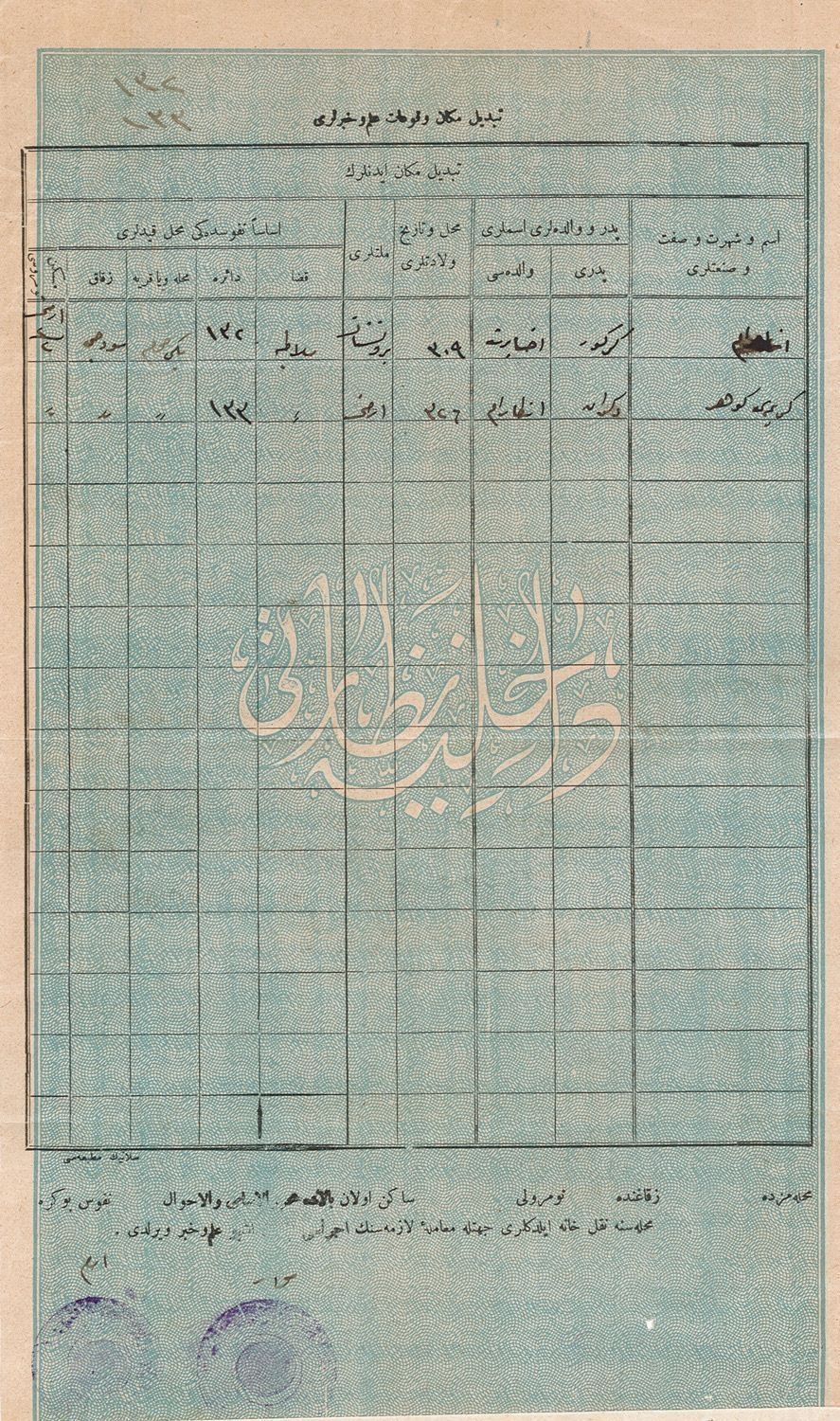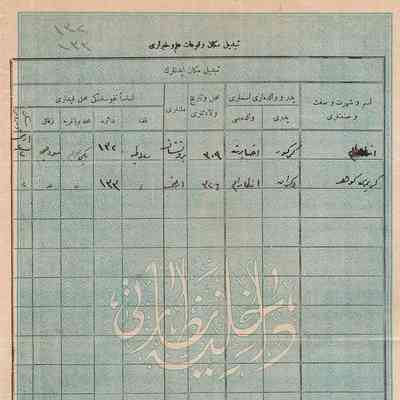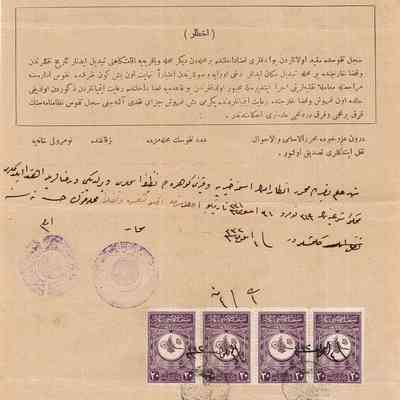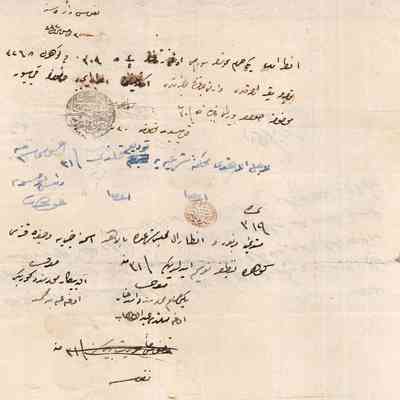Ottoman Armenian Document #29

Page 1
1st row: Name: Antaram Father: Kirkor Mother: Ihsaberta (Yeghisapet) Birth year: (1)309 (1893-4) Millet: Protestant Kaza: Malatya Block? (Daire): 132 Neighborhood: Yeni Hamam Street: Sudji (Sütçü) Residence number: (Armenian) 2-2 2nd row: Name: Her daughter (Kerimesi) Kojar Father: Dikran Mother: Antaram Birthyear: (1)326 (1910) Millet: Armenian ('Protestant Armenian' took both first- and second-row boxes) Kaza: "" Block? (Daire): 133 Neighborhood: "" Street: "" Residence number: ""
Name/Title
Ottoman Armenian Document #29Scope and Content
Dated between 12 September 1915 and 12 September 1916, this Ottoman petition provides a deeply personal glimpse into the bureaucratic aftermath of religious conversion during the Armenian Genocide. Addressed to the local district governor (Mutasarrıf), the document opens with the invocation "In the name of God (Bihi)" and follows the formal language of Ottoman administrative petitions. The petitioner, a woman named Antaram, identifies herself as the daughter of Kevork, son of Der Kevork, from the Manador neighborhood, and the wife of Sarrafyan Yazmacı Dikran of the Yeni Hamam neighborhood. She states that she and her seven-year-old daughter have embraced Islam, but neither has been officially registered in the population ledger nor issued the required Ottoman identity document (Tezkire-i Osmaniye). She respectfully requests that the authorities recognize their new religious status and provide the necessary documentation. In the formal closing, she acknowledges the supreme authority of the state. In the stamp and signature section, she is referred to by her new Muslim name, Hayriye, while her daughter Kohar is now called Nazife—a transformation that signaled not just a change in religion, but a redefinition of identity under duress. This document reflects one of countless cases during the Armenian Genocide (1915–1916) in which Armenian women and children were forcibly converted to Islam as a means of survival. Under the guise of assimilation, the Ottoman state and local actors subjected Armenians to systemic deportations, mass violence, and the destruction of communal structures. Those who converted—whether voluntarily, semi-voluntarily, or under threat—were sometimes absorbed into Muslim households, orphanages, or institutions. Obtaining a Tezkire-i Osmaniye was not only a legal necessity but also a symbolic and practical validation of their new, state-approved identity. While many of these conversions were compelled by circumstance and fear, and were later reversed when possible, they left lasting scars on individuals and communities. Petitions like Antaram’s remain as testimonies of survival, loss, and the painful bureaucratic reality of cultural erasure during one of the 20th century’s first genocides.Category
Misc. Documents



![Page 4: To the exalted presence of His Excellency, the honorable Mutasarrıf (district governor):
This is my humble petition:
Although I am the daughter of Kevork, son of Der Kevork, from the Minaver neighborhood, and the wife of Sarafyan Yazmacı Dikran from the Yeni Hamam neighborhood, and although I, together with my seven-year-old daughter, have embraced the true religion of Islam, I have not yet been registered in the population ledger nor been issued an Ottoman identity document (Tezkire-i Osmaniye).
Therefore, I respectfully request that an order be issued for us to be registered in the population records and granted our Tezkire-i Osmaniye.
Ultimately, the command belongs to His Excellency who holds authority.
Stamp and signed area: From 12 September 1915 / 12 September 1916: Antaram, a convert named Hayriye, daughter of Kevork son of Der Kevork from the Manador neighborhood and wife of Sarrafyan Yazmacı Dikran from the Yeni Hamam neighborhood. This, too, is her daughter, the convert named Kohar, now called Nazife.
Original transcription:
Bihi.
Huzur-ı âlî-i hazret-i mutasarrıf-ı ekremiyeye,
Mârûz-ı câriyeleridir ki:
Manador Mahallesi’nden Der Kevork oğlu Kevork’un kerîmesi ve Yeni Hamam Mahallesi’nden Sarafyan Yazmacı Dikran’ın zevcesi olduğum hâlde, yedi yaşında bir nefer kız çocuğumla birlikte dîn-i mübîn-i İslâmiyet’i kabul etmiş isem de, henüz cerîde-i nüfûsa kayd olunmayıp ve Tezkire-i Osmâniye dahi ahz edememiş olduğumdan, lütfen nüfûsa bi’l-kayd Tezkire-i Osmâniye i‘tâ buyurulması bâbında emr ü fermân hazret-i men-lehü’l-emrindir.
Fi 30 Ağustos 1331 – Fi 30 Ağustos 1332 / Manador Mahallesinden Der Kevork oğlu Kevork kızı [ve] Yeni Hamam Mahallesinden Sarrafyan Yazmacı Dikran’ın zevcesi Antaram nâm mühtediye Hayriye. Bu dahi kerimesi Kohar nâm Mühtediye Nazife.](https://d3f1jyudfg58oi.cloudfront.net/15232/image/91179ca0-22c9-11f0-ab6b-4939883e6ced-vKvZoJU.tn@2x.jpg)